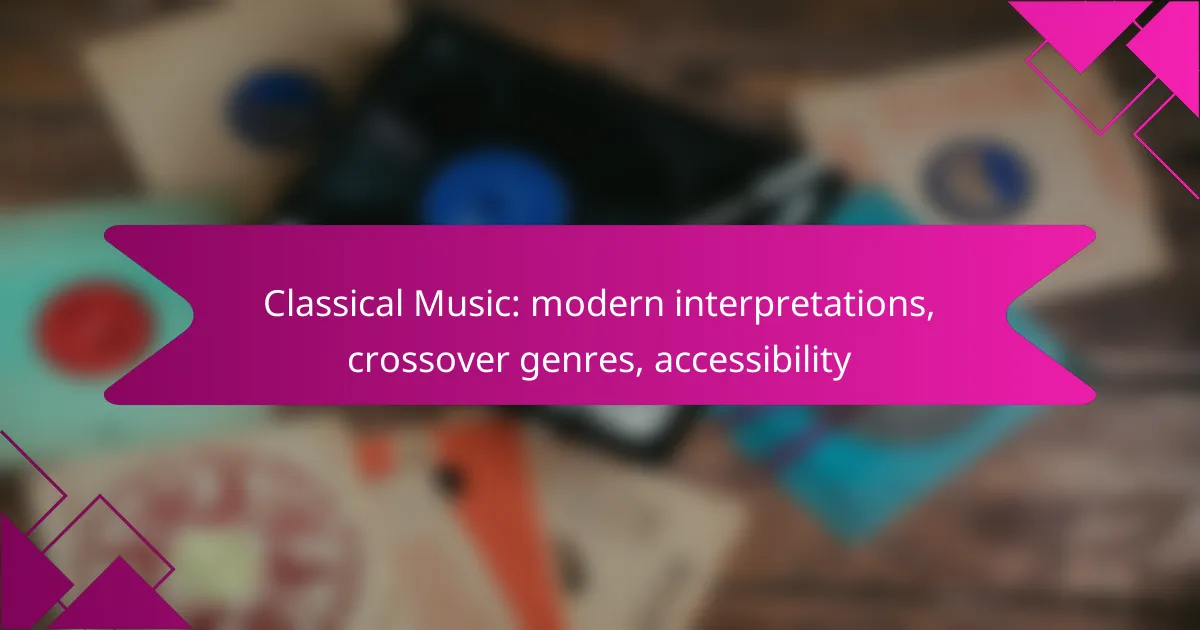Modern interpretations of classical music are reshaping the genre by merging traditional elements with contemporary styles, thereby enhancing its accessibility and appeal. Crossover genres, which incorporate influences from pop, jazz, and rock, attract a diverse audience and make classical music more engaging. Additionally, the rise of digital platforms and online resources is further democratizing access to this timeless art form.
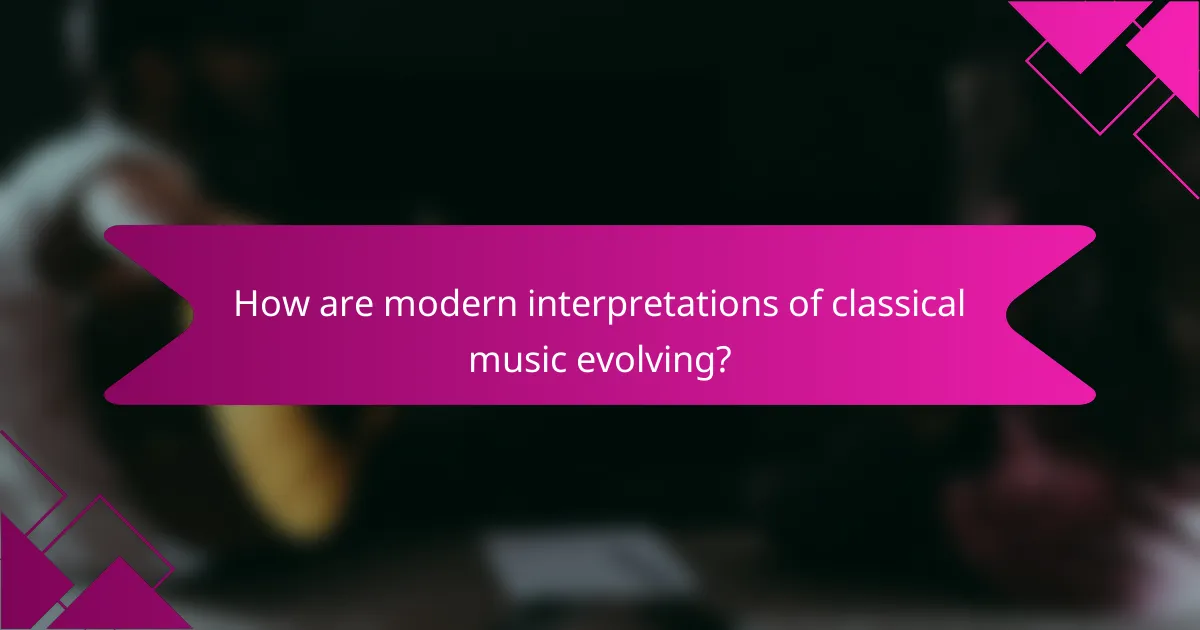
How are modern interpretations of classical music evolving?
Modern interpretations of classical music are evolving through innovative approaches that blend traditional elements with contemporary styles. This evolution enhances accessibility and attracts diverse audiences, making classical music more relevant in today’s musical landscape.
Fusion with electronic music
The fusion of classical music with electronic music has created a dynamic soundscape that appeals to younger listeners. Artists often incorporate synthesizers, samples, and digital effects, transforming classical compositions into vibrant, modern tracks.
For example, orchestral pieces may be reimagined with electronic beats, creating a unique listening experience that retains the essence of the original while introducing new textures. This blend can be found in various settings, from live performances to studio recordings.
Influence of popular music genres
Classical music is increasingly influenced by popular genres such as rock, hip-hop, and pop. This cross-pollination allows classical musicians to experiment with familiar rhythms and melodies, making their work more relatable to a broader audience.
Collaborative projects often feature classical instruments alongside electric guitars or rap verses, showcasing how these genres can coexist. This trend not only revitalizes classical music but also encourages a new generation of fans to explore its rich history.
Innovative orchestral arrangements
Innovative orchestral arrangements are reshaping how classical music is performed and perceived. Composers are reworking traditional scores to include unconventional instruments or to adapt them for smaller ensembles, making performances more versatile.
These arrangements can vary from incorporating jazz elements to using multimedia elements like visual art or dance. Such creativity enhances the audience’s experience, drawing in those who might not typically attend a classical concert.
Collaborations with contemporary artists
Collaborations between classical musicians and contemporary artists are becoming more common, bridging the gap between genres. These partnerships often result in unique projects that blend different musical styles, attracting fans from both worlds.
Notable examples include classical musicians working with pop stars or hip-hop artists to create crossover albums. These collaborations not only expand the reach of classical music but also foster a greater appreciation for its versatility and relevance in modern culture.
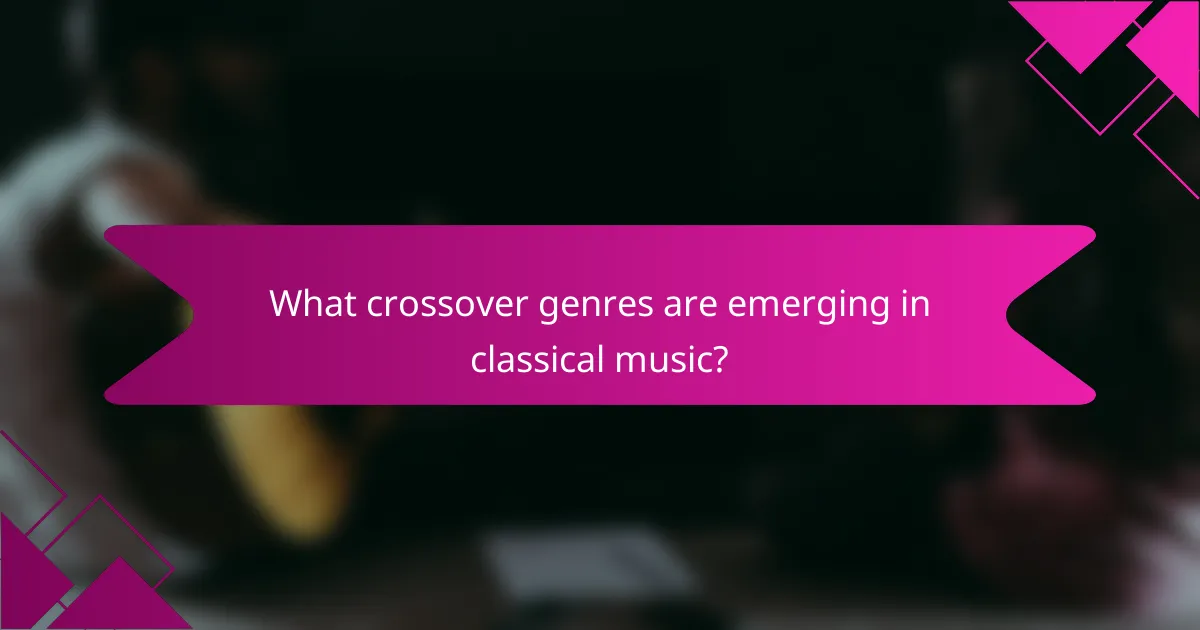
What crossover genres are emerging in classical music?
Crossover genres in classical music blend traditional elements with contemporary styles, creating innovative sounds that appeal to diverse audiences. These genres often incorporate influences from pop, jazz, and rock, making classical music more accessible and engaging for modern listeners.
Classical crossover
Classical crossover merges classical music with popular genres, allowing artists to reach broader audiences. This genre often features classical instruments performing alongside pop or rock vocals, creating a unique sound that retains the sophistication of classical music while appealing to mainstream tastes.
Notable examples include artists like Andrea Bocelli and Il Divo, who have successfully blended operatic vocals with pop melodies. This approach can attract younger listeners who might not typically engage with traditional classical music.
Jazz-infused classical
Jazz-infused classical music combines improvisational elements of jazz with structured classical forms. This genre allows for creative expression, as musicians often reinterpret classical pieces through a jazz lens, adding syncopation and swing.
Collaborations between classical musicians and jazz artists, such as the works of Claude Debussy and George Gershwin, exemplify this fusion. The interplay between the two styles can create dynamic performances that highlight the strengths of both genres.
Rock and classical collaborations
Rock and classical collaborations bring together the energy of rock music with the orchestral richness of classical compositions. This genre often features rock bands performing with symphony orchestras, enhancing the emotional impact of their music.
Examples include the London Philharmonic Orchestra’s collaborations with bands like Metallica and Pink Floyd, where classical arrangements elevate the rock experience. These performances can introduce classical music to rock fans, fostering a greater appreciation for both styles.
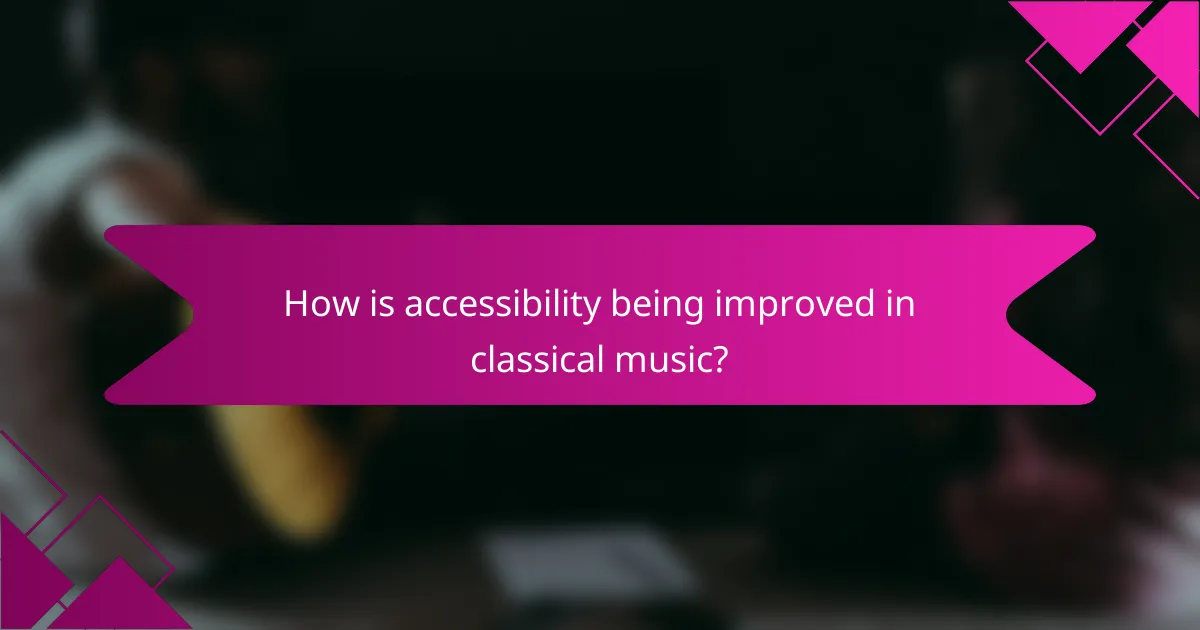
How is accessibility being improved in classical music?
Accessibility in classical music is being enhanced through various innovative approaches, making it easier for diverse audiences to engage with the genre. Key improvements include the rise of digital platforms, virtual events, and a wealth of online educational resources.
Digital streaming platforms
Digital streaming platforms have revolutionized how audiences access classical music. Services like Spotify, Apple Music, and YouTube offer vast libraries of classical compositions, allowing listeners to explore everything from well-known symphonies to contemporary works. Many of these platforms provide curated playlists and recommendations, making it easier for newcomers to discover classical music.
Additionally, some platforms offer high-definition audio options, enhancing the listening experience. Subscriptions typically range from free to around $10 per month, making it financially accessible for many users.
Virtual concerts and events
Virtual concerts and events have emerged as a popular way to experience classical music from the comfort of home. Many orchestras and ensembles now stream performances live or provide recorded concerts on their websites and social media channels. This shift allows audiences worldwide to enjoy performances that they might not have access to locally.
These virtual events often include interactive elements, such as Q&A sessions with musicians or behind-the-scenes tours, further enriching the experience. Access to these events is often free or available for a nominal fee, making it an affordable option for many music lovers.
Educational resources online
Online educational resources are making classical music more accessible to learners of all ages. Websites, YouTube channels, and online courses offer tutorials, lectures, and interactive content that cater to various skill levels. Many of these resources are free or low-cost, encouraging wider participation.
For example, platforms like Coursera and Khan Academy provide courses on music theory and appreciation, while YouTube features channels dedicated to explaining classical compositions and their historical contexts. These resources help demystify classical music and foster a deeper understanding and appreciation among audiences.
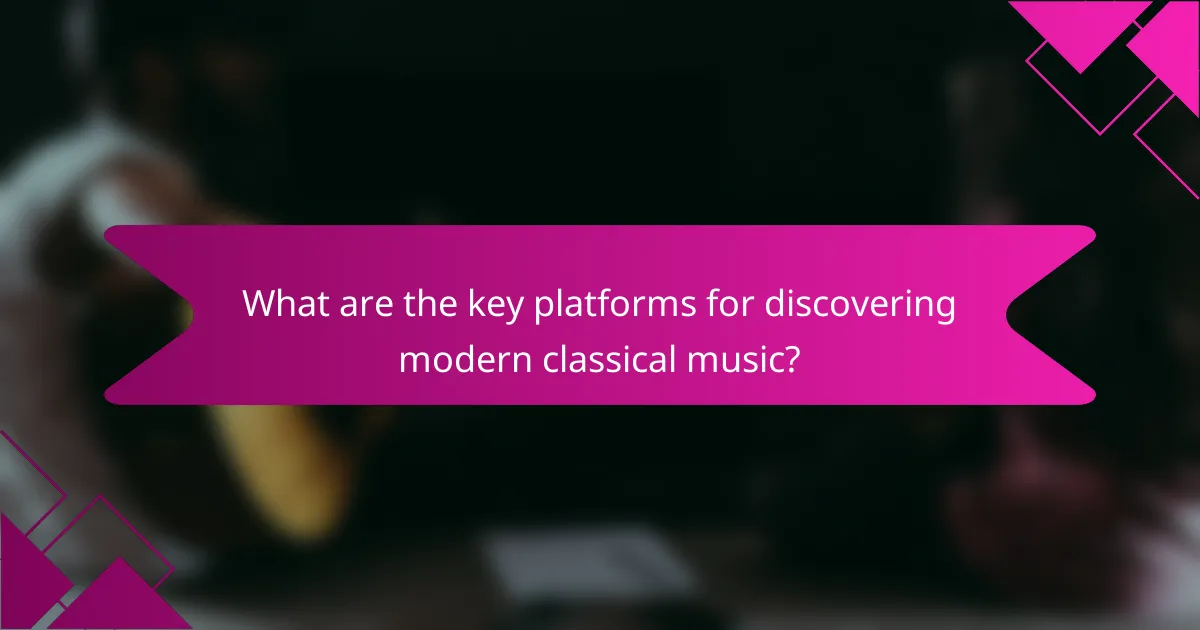
What are the key platforms for discovering modern classical music?
Key platforms for discovering modern classical music include streaming services and video platforms that curate specialized playlists and collections. These platforms offer a wide range of contemporary compositions, making it easier for listeners to explore and enjoy this genre.
Spotify playlists
Spotify features numerous playlists dedicated to modern classical music, allowing users to discover new artists and compositions effortlessly. Playlists like “Modern Classical Essentials” and “Contemporary Classical” provide curated selections that highlight both well-known and emerging composers.
When using Spotify, consider following playlists that are regularly updated to keep your listening experience fresh. You can also create your own playlists by combining tracks from different genres, enhancing your exploration of crossover styles.
Apple Music classical collections
Apple Music offers classical collections that showcase contemporary works alongside traditional pieces. Their curated playlists, such as “Classical Chill” and “New Classical,” feature a mix of genres, making it easy to find music that resonates with modern tastes.
To make the most of Apple Music, utilize the “For You” section, which recommends music based on your listening habits. This personalized approach helps you discover new classical music that aligns with your preferences.
YouTube channels for classical music
YouTube hosts various channels dedicated to modern classical music, providing both audio and visual experiences. Channels like “Classical Music Only” and “The Classical Channel” feature performances, interviews, and discussions that deepen your understanding of contemporary compositions.
Engaging with these channels can enhance your appreciation for modern classical music. Look for live performances and documentaries that offer insights into the creative processes of contemporary composers, enriching your overall experience.
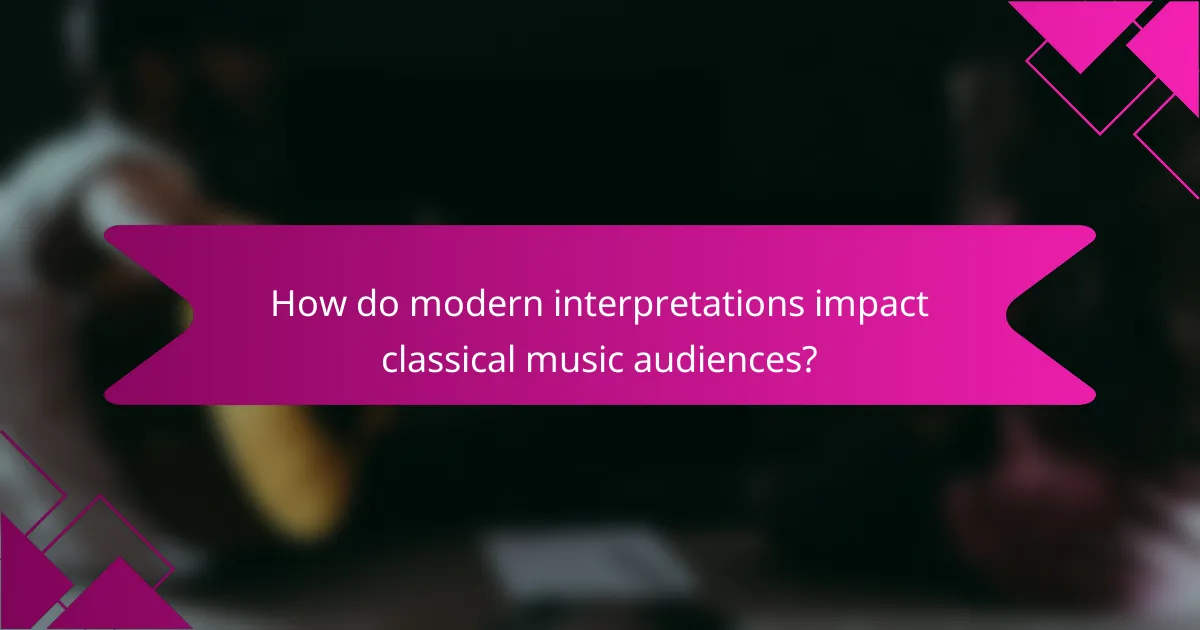
How do modern interpretations impact classical music audiences?
Modern interpretations of classical music significantly broaden its appeal, drawing in diverse audiences and enhancing engagement. By incorporating contemporary elements and crossover genres, these interpretations make classical music more accessible and relatable to today’s listeners.
Attracting younger listeners
Modern interpretations often feature innovative arrangements and collaborations with popular artists, which resonate with younger audiences. For instance, orchestras may perform symphonic renditions of film scores or pop hits, creating a bridge between classical music and contemporary tastes.
Additionally, the use of technology, such as streaming platforms and social media, allows younger listeners to discover classical music in a familiar context. Engaging content, like video performances and interactive experiences, can further entice this demographic to explore classical works.
Enhancing cultural relevance
By adapting classical music to reflect current social themes and cultural movements, modern interpretations enhance its relevance. Composers and conductors are increasingly incorporating elements from various genres, such as jazz, hip-hop, and electronic music, to address contemporary issues and connect with a broader audience.
Furthermore, collaborations with artists from different backgrounds can introduce classical music to new cultural narratives, enriching its storytelling potential. This approach not only revitalizes classical pieces but also fosters a sense of community and shared experience among diverse listeners.

What role do festivals play in showcasing modern classical music?
Festivals are crucial for highlighting modern classical music by providing a platform for innovative performances and new works. They create opportunities for composers and musicians to reach wider audiences, fostering appreciation for contemporary interpretations and crossover genres.
Promoting new compositions
Festivals often feature world premieres of new compositions, allowing audiences to experience fresh works in a live setting. This not only supports composers but also encourages the exploration of diverse musical styles and techniques. For example, festivals may dedicate entire programs to avant-garde pieces or collaborations with other genres, enhancing the overall cultural landscape.
To maximize the impact of new compositions, festivals can engage with local communities and educational institutions, offering workshops and discussions that deepen understanding and appreciation. This approach helps bridge the gap between composers and audiences, making contemporary music more accessible.
Highlighting diverse artists
Modern classical music festivals frequently showcase a wide range of artists from various backgrounds, promoting inclusivity within the genre. By featuring musicians from different cultural and musical traditions, festivals can challenge traditional norms and broaden the audience’s perspective on classical music.
Additionally, festivals can implement initiatives to support underrepresented artists, such as mentorship programs or funding opportunities. This not only enriches the festival experience but also helps cultivate a more diverse artistic community, ultimately benefiting the genre as a whole.
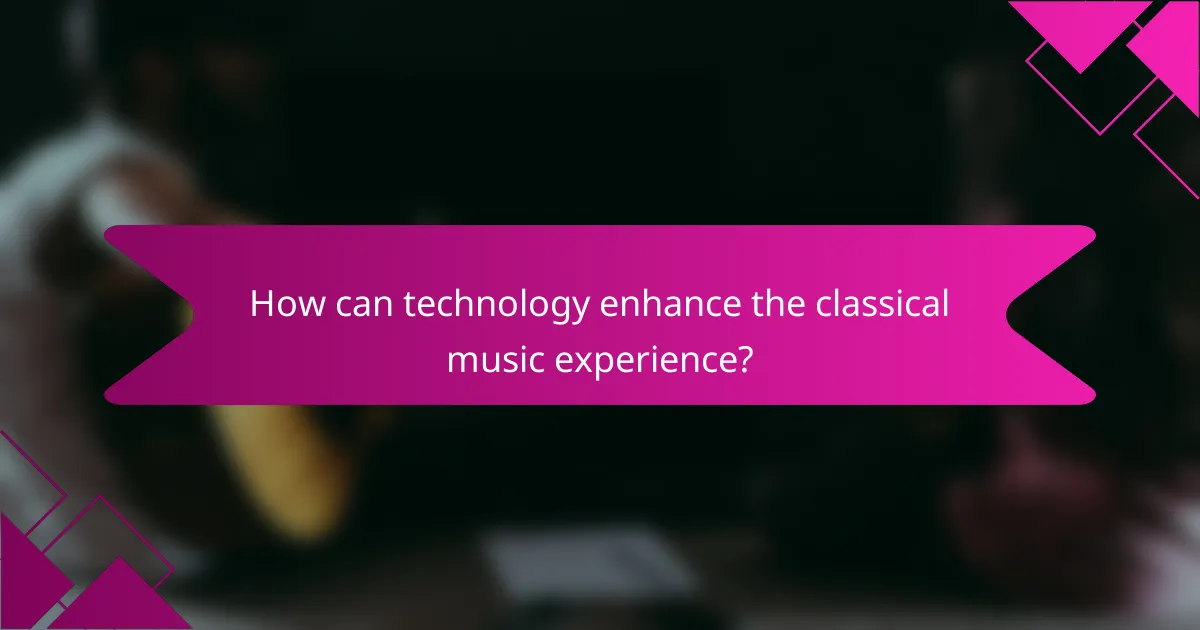
How can technology enhance the classical music experience?
Technology enhances the classical music experience by providing innovative ways to access, interact with, and appreciate the genre. From streaming services to virtual reality concerts, these advancements make classical music more accessible and engaging for a broader audience.
Streaming Services and Accessibility
Streaming services have revolutionized how audiences access classical music. Platforms like Spotify and Apple Music offer vast libraries where listeners can explore a wide range of composers and performances without geographical limitations.
Many of these services provide curated playlists and recommendations, making it easier for newcomers to discover classical music. Subscriptions typically range from a few dollars per month to around ten dollars, depending on the service and features.
Virtual Reality and Immersive Experiences
Virtual reality (VR) technology allows audiences to experience classical music in immersive environments. Users can attend virtual concerts from the comfort of their homes, feeling as if they are part of the live performance.
This technology often includes interactive elements, such as the ability to choose different camera angles or explore the concert hall. While VR headsets can be costly, many platforms offer affordable options, making these experiences more accessible.
Mobile Apps for Learning and Engagement
Mobile applications designed for classical music education and engagement have become increasingly popular. Apps like Smartify and Classical Music Navigator provide information about composers, pieces, and historical context, enhancing listeners’ understanding.
These apps often include features like quizzes, listening guides, and interactive timelines, making learning engaging. Many are free or available for a nominal fee, encouraging users to deepen their appreciation of classical music.
